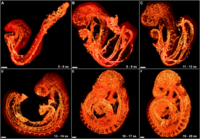
Photo from wikipedia
NADPH oxidase-derived reactive oxygen species (ROS) regulates platelet function and thrombosis. It remains controversial regarding NOX2’s role in platelet function. As a regulatory subunit for NOX2, whether p47phox regulates platelet… Click to show full abstract
NADPH oxidase-derived reactive oxygen species (ROS) regulates platelet function and thrombosis. It remains controversial regarding NOX2’s role in platelet function. As a regulatory subunit for NOX2, whether p47phox regulates platelet function remains unclear. Our study intends to evaluate p47phox’s role in platelet function. Platelets were isolated from wild-type or p47phox-/- mice followed by analysis of platelet aggregation, granule secretion, surface receptors expression, spreading, clot retraction and ROS generation. Additionally, in vivo hemostasis, arterial and venous thrombosis was assessed. Moreover, human platelets were treated with PR-39 to inhibit p47phox activity followed by analysis of platelet function. p47phox deficiency significantly prolonged tail-bleeding time, delayed arterial and venous thrombus formation in vivo as well as reduced platelet aggregation, ATP release and αIIbβ3 activation. In addition, p47phox-/- platelets presented impaired spreading on fibrinogen or collagen and defective clot retraction concomitant with decreased phosphorylation of Syk and PLCγ2. Moreover, CRP or thrombin-stimulated p47phox-/- platelets displayed reduced intracellular ROS generation which was further decreased after inhibition of NOX1. Meanwhile, p47phox deficiency increased VASP phosphorylation and decreased phosphorylation of ERK1/2, p38, ERK5 and JNK without affecting AKT and c-PLA2 phosphorylation. Furthermore, p47phox translocates to membrane to interact with both NOX1 and NOX2 after stimulation with CRP or thrombin. Finally, inhibition of p47phox activity by PR-39 reduced ROS generation, platelet aggregation and clot retraction in human platelets. In conclusion, p47phox regulates platelet function, arterial and venous thrombus formation and ROS generation, indicating that p47phox might be a novel therapeutic target for treating thrombotic or cardiovascular diseases.
Journal Title: Redox Biology
Year Published: 2020
Link to full text (if available)
Share on Social Media: Sign Up to like & get
recommendations!